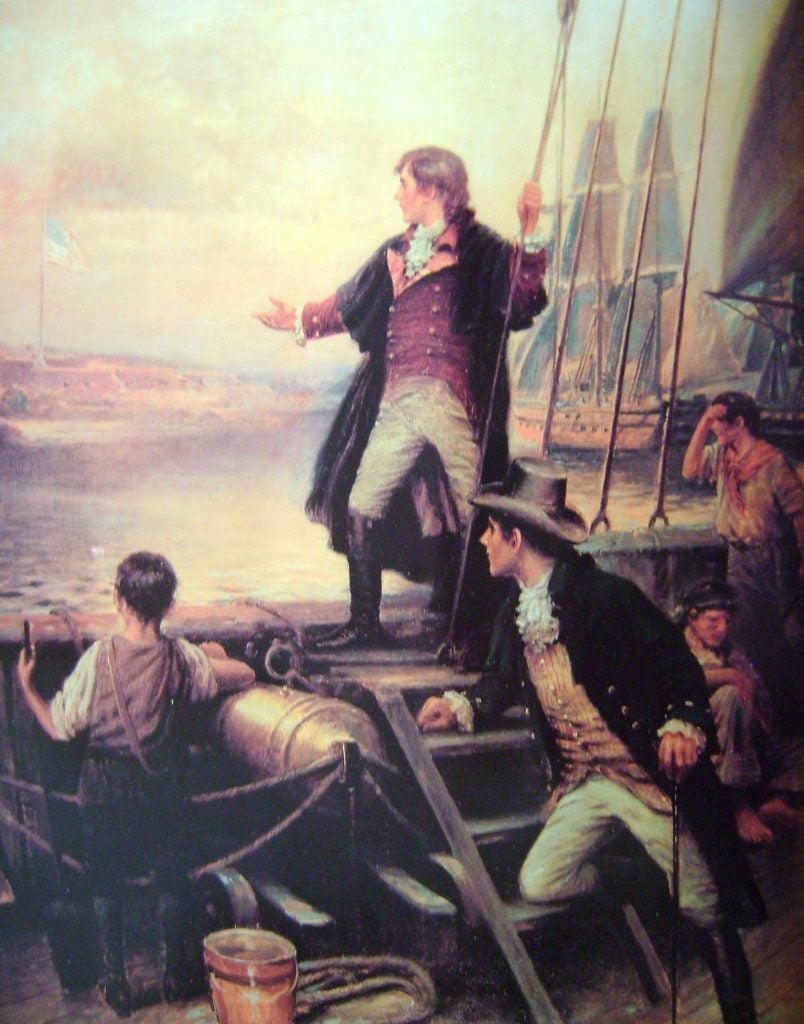MYTH #1: Francis Scott Key was held prisoner aboard a British ship during the bombardment of Baltimore
CORRECTION: Key was aboard his own American truce ship during the battle
Key and fellow lawyer John S. Skinner, the U.S. Agent for Prisoners of War, sailed from Baltimore on September 5, 1814 on an American truce ship and headed down the Patapsco River hoping to meet the British fleet somewhere in the Chesapeake Bay. They were on a mission of mercy to negotiate the release of the elderly Dr. William Beanes, a civilian non-combatant who had been taken prisoner by the British as they departed Washington, DC after burning the White House, the Capitol, and other government buildings in revenge for the U.S. burning of York (current day Toronto) in April 1813. Key was a persuasive addition to the negotiating team because of his close family ties to both the United States and England. His father served in the Continental Army; his uncle remained a British loyalist during the Revolution. Key’s mission was a success.
During their talks and then upon the release of the doctor, Key, and Beanes were moved from the H.M.S. Tonnant, where they had negotiated with British Admiral Cochrane, to the H.M.S. Surprise and finally back to their own American truce ship. (The exact name of this ship has defied generations of researchers.) During the harrowing 25-hour bombardment, their ship was tethered to a British vessel (one not involved in the fighting) and placed under guard in order to prevent Key and his companions from revealing to Baltimore’s defenders any attack plans overheard. Key was likely some six to eight miles from America’s Fort McHenry, which guarded against certain American defeat by protecting the entrance to Baltimore’s harbor. Superior British weapons pounded the fort from newly designed bomb ships anchored safely out of range of the fort’s own guns. Yet Key rose on the morning of September 14, 1814 and through the lens of his spyglass saw his nation’s 15-star, 15-stripe flag waving defiantly over the fort. He was elated and relieved, certain that God had intervened. He spent the next two days waiting for the British to depart, when they would release him and his compatriots. And what does a patriotic poet do when stuck with nothing to do and having witnessed a momentous event? He wrote the lyrics of a song to a well-known melody that he knew well.

One source of confusion over Key’s whereabouts during the battle is Percy Moran’s commonly reprinted painting “By Dawn’s Early Light” (1912). Painted 98 years after the event depicted, the image offers a romantic reimagining of the scene. Moran portrays Key aboard a British vessel and much too close to the fort as the flag is revealed by the rising sun. Such artistic license allows the painter to contrast American joy with British despair and to show Fort McHenry’s flag more prominently to the viewer than if he had shown Key miles away looking at a tiny fort through a spyglass. Yet, as a result a Spangled Mythconception was created and it thrives today… (at least until now).
SPANGLED MYTHCONCEPTIONS SERIES, by Mark Clague, Ph.D.
Intro | Key Wrote Anthem on an Envelope


